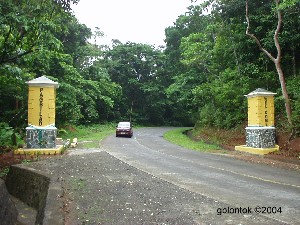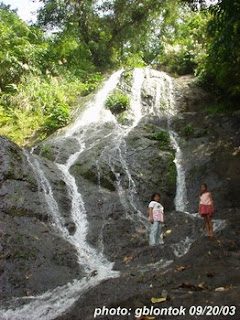Tubahin Beach
N13°55.1841' E121°44.4634'
Sitio Tubahin in Brgy. Ibabang Polo in Pagbilao Grande Island is a host
to nice beaches. At least one was developed into a resort with open
cottages/sheds made of nipa and bamboo among its facilities. It is
accessible to vehicles through the concreted barangay road, then
through an unpaved private road at a distance of approximately 2 km from
the junction.N13°55.1841' E121°44.4634'
Entrance fee is PhP20 per person. Parking fee is at PhP40. Cottages may be rented at a reasonable rate (it varies). During peak season in summer months, a canteen is put up where beachgoers may order food and drinks. During lean months however, the canteen does not operate but the food may be ordered from the caretaker and is then cooked and shuttled from a restaurant which they also own.
Freshwater for bathing is trucked-in and has to be bought also.
|
The beach looks brownish but becomes white when the sand gets dried under the sun |
In the far background is the Pagbilao Power Station in Sitio Capalos |
The beach is about 150meters long. Best of all - there are no entrance fees (for now). Trees provide shade against the sun. Everything from tents, mats and other gears and provisions must be brought in.
|
View facing northeast showing the long and wide beach with fine brownish sand |
View facing southwest showing where a creek meets the sea |
A farming family lives in the parcel of land bounded by this beach. Leaving a little amount for clean-up is recommended.
There is no fresh water near the beach, but there are public faucets along the Quipot-Capalos road.
How to get there?
The access to Tubahin Beaches is along the Binahaan-Quipot-Capalos Road
which is the access road to Pagbilao Coal-Fired Power Plant. This road
branches out from the National Highway; hence, part of the narrative for
a nearby feature “kwebang Lampas” is reprinted here:From Pagbilao, just follow the National Highway going to Atimonan. The first Y-junction, a few hundred meters after KM 146 and just infront of Binahaan Elementary School, is the access road to Pagbilao Coal-Fired Power Plant. It is marked by an impressive modern directional sign which looks out of place in a rural setting. So follow that sign which tells you to take the junction to the right. Just a few meters therein will be a railroad crossing without a safety barrier, so stop, look and listen. You will notice that the road's kilometer posts are not related to the ones in the main highway. Be watchful of road humps strategically placed at school zones, barangay centers, pedestrian crossings and dirt road junctions. |
||
| The concrete road passes thru Brgy. Binahaan. Then, going across the
Spillway over Locohin River will take you thru a winding and rolling
road within Brgy. Kanlurang Malicboy. In the vicinity of KM8, you can
leave the Island of Luzon without having to fly or to swim, because
Quipot Bridge is there to connect Brgy. Kanlurang Malicboy in the Luzon
mainland and Brgy. Ilayang Polo in Pagbilao Grande Island. After driving for about 4km thru the Island, find the Sitio Tubahin marker to your right. Enter the concrete barangay road. After about 1.2km, veering to the right from this road is an unpaved private road which is the access to the resort. After half a kilometer is the entrance to the resort. After a farther 500 meters northwest is the other beach with no entrance fee. Photos and Narratives by Engr. Gerry B. Lontok ©2009 |
||























































